Whenever I handle an old gun — and I mean an old gun — I wonder what firearms I’ll leave to my kids and grandkids. Will they have the same charm and unique nature as a truly old gun? How cool is an AR when there are tens of millions of them?
I don’t think an in herited AR will have the same kind of old school cool as the Remington 241 Speedmaster. The 241 is a John Moses Browning design, and the Browning SA-22, which is still sold, is nearly identical to it. This rimfire rifle is chambered in .22 LR and is a semi-automatic design.
The 241 replaced the older Browning-designed Model 24 and was considered an improved variant. It also accommodated more cartridges than .22 Short. Over 100,000 rifles were produced, and this particular model was built in 1936.
Believe it or not, the Remington 241 saw some military service. Sort of, anyway. Remington sold several thousand rifles to the military as training rifles during World War II.

This particular model belongs to my girlfriend’s 99-year-old grandfather, and it needed a good cleaning, oiling, and some love to get it back into fighting shape. The top photo shows the owner’s great-granddaughter holding it.
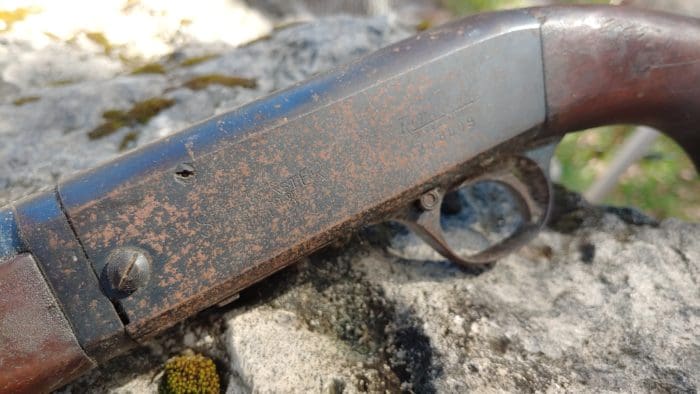
The rifle had gained a level of surface rust, and a gooey combination of gun oil and thick dust was gumming up the action. When I received the Remington 241, the trigger, charging handle, takedown nut, and safety were all stiff and hard to move. With some Hoppe’s No. 9, some very fine steel wool, an AP brush, and an old T-shirt, I dedicated an afternoon to cleaning and learning about the Remington 241 Speedmaster.
Remington 241 Breakdown
As the words ‘takedown nut’ reveal, this is a takedown rifle, as are the Browning SA-22 designs. The big difference between the two rifles is how you adjust the barrels to fit with the receiver. These devices are necessary due to the takedown design.
The Browning design used an adjusting ring at the base of the barrel. The Remington 241 uses a double-sided nut. This particular model had a nice tight fit, so I left the screw well enough alone. I’ve messed up plenty of good things trying to make them better.

To take down the Model 241, you pull a tab down and twist the barrel and forend. It pops right off. Well, it pops right off now. After some oil and scrubbing, it’s relatively smooth and pops on and off with ease.
The same could be said for the takedown nut. It hardly moved and took a lot of force, oil, and work to loosen it up.
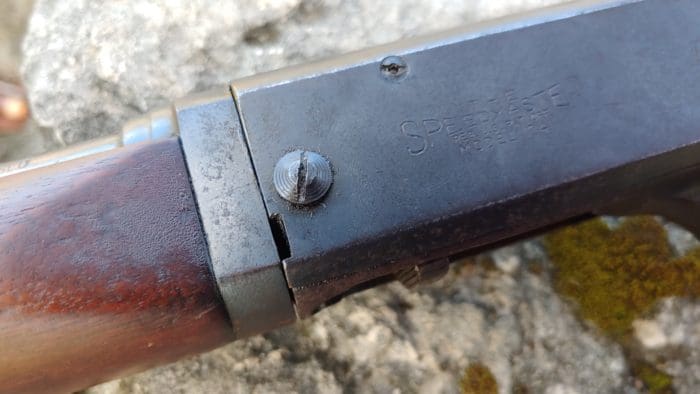
The Rimfire Remington
The Remington Model 241 was produced in both .22 LR and .22 Short. This example is a long rifle variant. The design is slick and slim and it’s hard not to be charmed by it.
There is no side charging handle or ejection port, and no beneath-the-barrel tube magazine. The rifle is very smooth. The charging handle is more of a tab and is placed at the bottom of the receiver.
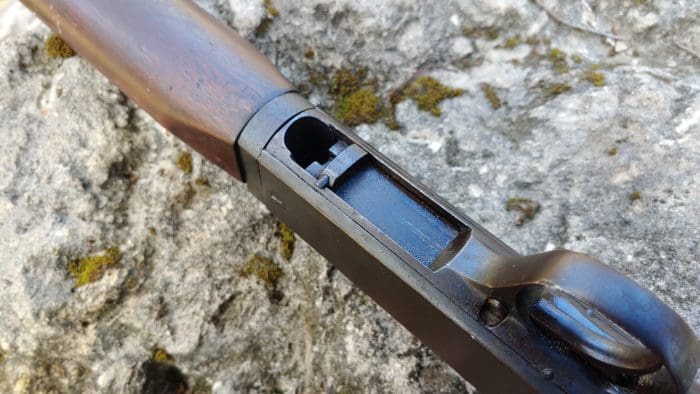
This area is also the ejection port. The magazine tube sits inside the stock, and you load the gun through the stock. The rifle can hold ten rounds of .22 LR.
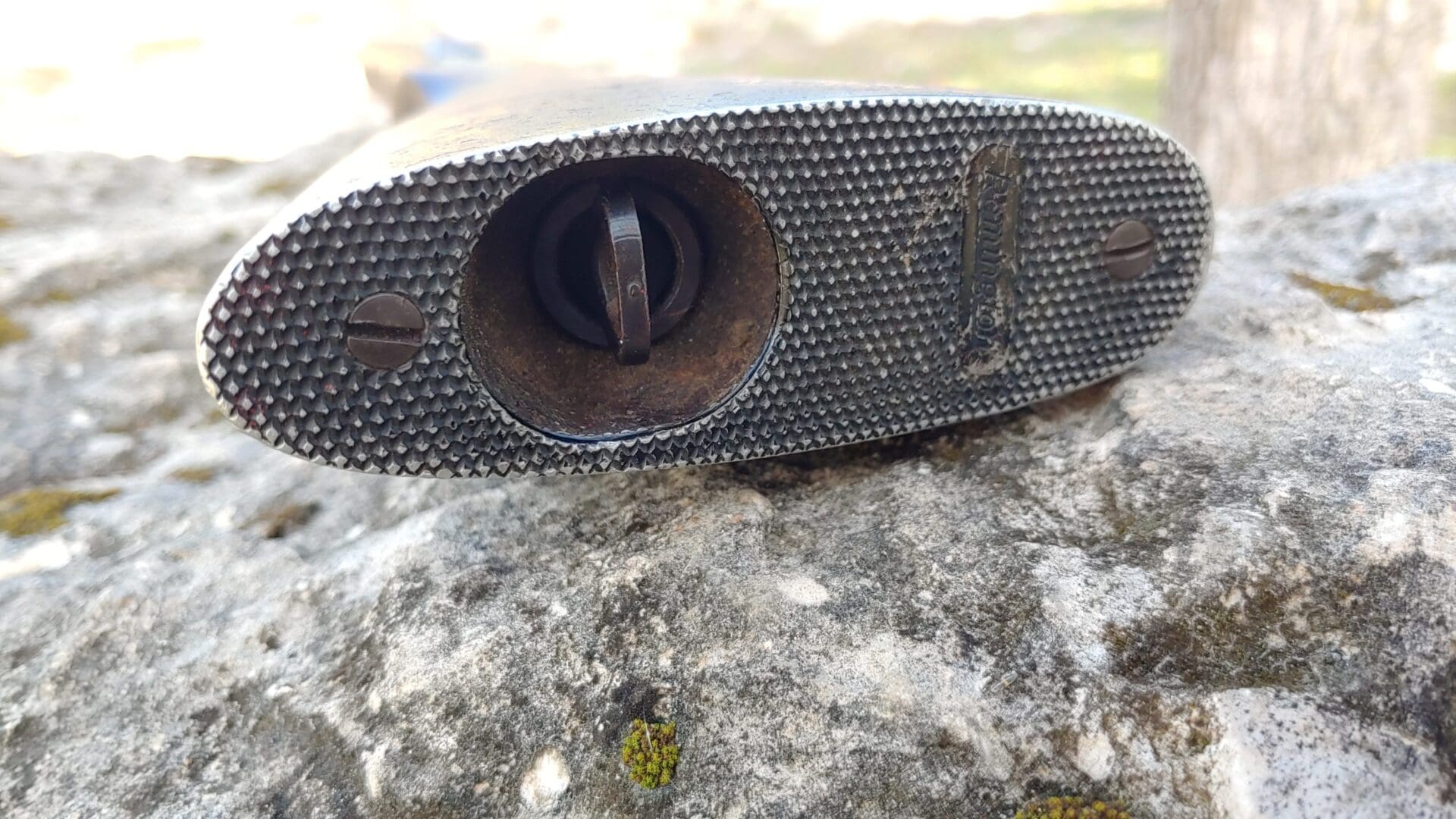


The 241 is very slim and weighs a mere six pounds. Admittedly you can make a .22 LR rifle lighter, and many have, but old school cool means old school weight. Real wood and a conspicuous lack of polymer mean the gun feels very gun-like.



The real wood stock and forend feel, look and even smell good. Years of oil, use, and love have given the rifle’s furniture a distinct patina of scratches gouges that give it a certain charm. This is no plasterboard stock we see on cheap “wood stocked” guns today. This is real wood, and you can feel the difference.
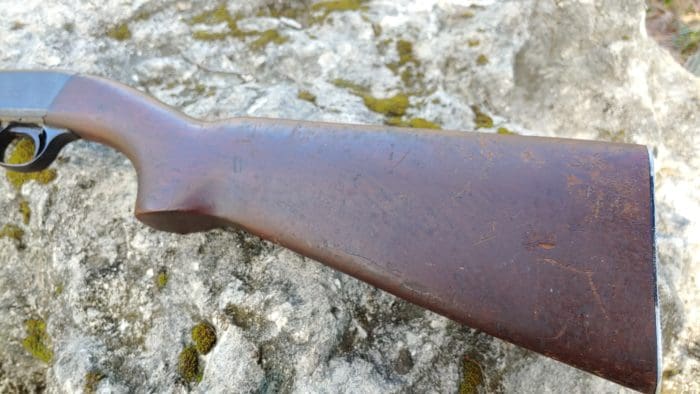

The Speedmaster’s barrel is quite long at 23.5 inches, and it gives you a nice long sight radius. The Remington 241 is topped with a set of open iron sights and a very fine and thin front sight. There doesn’t seem to be a means to attach an optic, and I would consider no such action even if there were. The sights aren’t exactly the high visibility, quick-on-target sights you’d want on a combat rifle. They are small, thin, and perfect for precise plinking shots.


Bootin’, Scootin’, and Shootin’
Speaking of shooting, the gun functioned perfectly. The semi-automatic action cycled through all ten rounds as fast as I could squeeze the trigger. In short, the gun lived up to its Speedmaster name.
While it seems silly during an ammo drought to waste gun food, you only live once, and I knew my time with the Remington 241 Speedmaster would be short. I fired nearly an entire box of Federal Automatch, and the gun worked without issue.


As you’d imagine, this sleek rifle handles like a kitten. Recoil and muzzle rise were that of any .22 LR. The sights are small, but they make it easy to hit your target. I popped off at paper targets, steel targets, and, of course, soda cans. The little Remington 241 proved to be plenty accurate, and I felt even better about leaving the adjustment nut alone.
The length of pull feels a bit long compared to most .22 LR rifles, and it’s about 13.5 inches long. The forend feels short, as I’m used to a more forward grip. However, as a .22 LR, none of these problems are real issues. The gun is effortlessly shootable and a lot of fun on the range. Loading is simple, and the tab charging device is odd but usable.
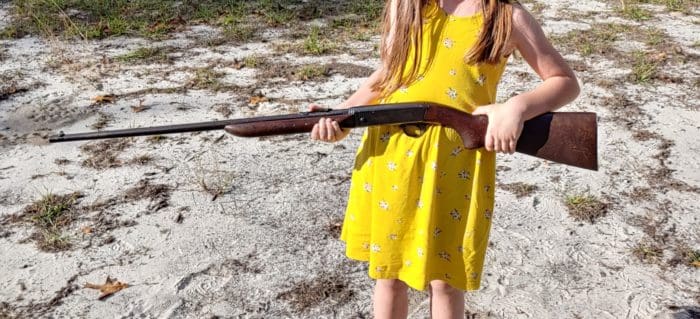

The Remington 241 would most certainly bring home plenty of small game to a hungry family, train kids how to shoot, and is an excellent working gun. I love old guns and my time on the range with this one. It’s easy to say Remington sucks these days, but it’s a lot harder to say anything bad about a Remington rifle built circa 1936.

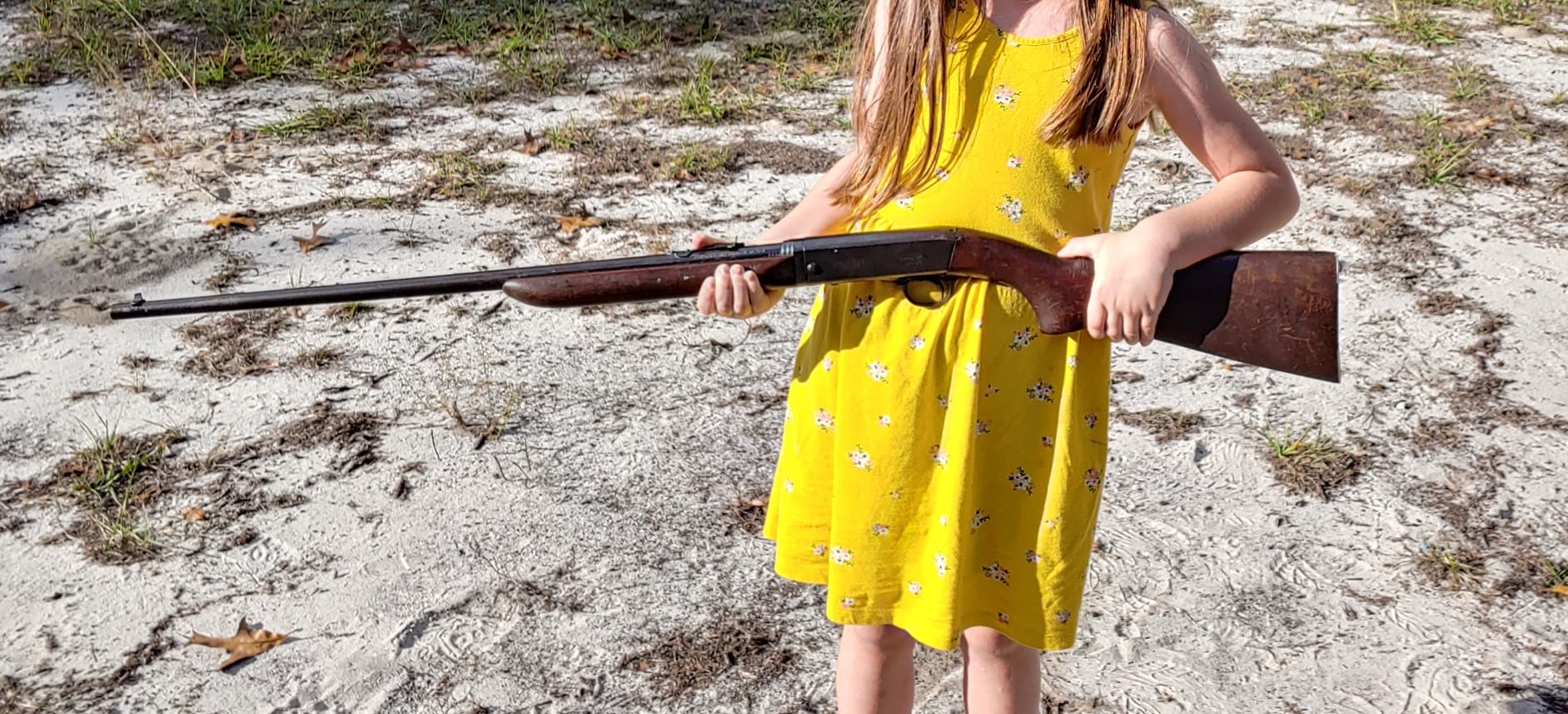



“….With some Hoppe’s No. 9, some very fine steel wool, an AP brush, and an old T-shirt,..”
Would electrolysis or white vinegar(racist) have been a choice for cleaning of the surface rust? That would have involved breaking it down completely though.
Nice rifle..I’ve seen several in the local pawn shops. Good write-up too!
No!! White vinegar will remove the blue.
So re-bluing is bad?
Our local gunsmith does hot-dipping.
If a firearm has no real collectors value but is something the individual vales then why not go all the way?
No, re-bluing is great, I have had many guns that are re-blued. the videos I mentioned from Anvil Gunsmithing in another comment on here were to show there are other alternatives to vinegar which will remove the original finish, or steel wool. Early guns were rust blued which you can do at home. He does a couple demo’s of that too. Some firearms will never be worth much down the road, you spend the $ in them because YOU want to, because it makes YOU happy. I had my Grandfathers side by side refinished and the salts are leaching out from the ribs. Nor I or my gunsmith knew that you never hot blue a double for that reason We have a plan to do a extended boil in distilled water to try and neutralize it. Doubles should always be rust blued.
Rebluing is not bad if you have a firearm that has little finish left or might need some serious scrubbing to remove rust or pitting. If the finish is intact it is better to maintain what is there. If you can clean it up and remove light surface rust and leave the original finish intact you are better off.
Please search for Anvil Gunsmith on the web. he offers videos on bringing old iron back to service. When I stumbled on him I’d hate to admit how many hours I spent watching the ones that interested me.
He does many on conservation of old firearms. Here’s a link to point you in the right direction
https://www.youtube.com/channel/UCM86hA7E1y3vOJuzdqCXh1Q
if you don’t have a pile of .22’s, well, you’re wrong.
I’m busily rectifying the situation… 🙂
hey, I’m working on it. I just got my first .22 AR… next is a .22 pistol (probably a glock)
Have the Remington speed master great gun like yours it was a rusty gun when I finally got it back bought the weapon in 1967 went to Vietnam in 68 sat in my cousins from 67 to 2018 cleaned it up put a scope on it… eyes are going… fires great and have had no issues with it… by the way I paid 37.50 brand new
why don’t they still make guns like this?
Browning does still make this. SA-22:
https://www.browning.com/products/firearms/rifles/sa-22-rifles.html
The prices may make you cry :
https://www.gunbroker.com/Rifles/search?Keywords=Browning%20SA-22&PageSize=24&Sort=4&View=1
Excellent write-up! Thank you!
241 Speedmaster is the .22 rifle my father taught me to shoot with. He still has it & uses it for pest control.
I would love to get one in .22LR to do as a restoration project. Problem is that I’ve only come across 2 others in my life. One was a .22 short that the shop wanted WAY TOO much for and the other was a parts gun that didn’t work & not exactly in a condition to use as a starting foundation to rebuild.
Anyways, thanks again for the memory flashbacks this holiday week.
I have the 552 Speedmaster, also and oldie but a goodie. Absolutely great gun. Never even knew there was a 241 until I read thus article.
Have a Browning SA-22 passed down to me from my grandfather. Still a great-shooting gun.
Had one for a long time. Beautiful gun that I learned to hate shooting due to the bottom ejection launching very hot brass onto my arms. Sold it finally.
I have a Belgian made Browning that was purchased new for $69 in 1960. It is a fine little rifle and I have a scope on it but haven’t fired it in years.
What a wonderful article. This was my Grandfathers go to rifle and I now have it. This was “The Gun” that my grandfather used the most. It was always, “Son, get The Gun it is under the seat in the truck be careful it is loaded!” Which was always followed by, “Ok son, go get that, squirrel, racoon, possum, crow, bullfrog, snake, etc. and I’ll tech ya how to skin it, clean it, etc. What great memories I had with my grandfather and “The Gun” growing up. I bet his granddaughter will have some as well.
Good good comment! Reminds me of Robert Ruark and Skeeter Skelton. Remember when we would roam ALL DAY through the woods with our .22s? We were Lords of the Plains! The best days of our lives. .22s are FUN!!
Wonderful wonderful writing! I will give you $800.00 for it RIGHT NOW! Aren’t the old ones sooo much fun to shoot! Never–ever put a scope on it. God Bless Big Green! I’ve got a bunch of old Remington .22s and love them all. All made before America lost it’s way. And I am a defender of our Home.
Its instead of it’s.
I have two .22s from the ’50s/’60s. Both in fantastic shape. One with a scope, the other maintained with factory irons. Love ’em both.
Inaccurate, failure to fire if not kept clean, overpriced for the time. Are you going to be able to hand firearms “down” to your grandchildren and will they care?
Ever fired one? Ever compared one with a contemporary? Any idea how well-made these things are? Ever take one apart to see just how intricate and finely-machined it is?
Didn’t think so.
This ain’t no ‘Nylon 66,’ and it’s not a ‘boy’s rifle.’ It’s a top-of-the-line adult’s gun, machined from solid steel billet and intended to last several lifetimes. Which it has.
This is what Remington universally produced, prior to 1948.
And what is wrong with a Nylon 66??
It was. My first gun, bought by my brother when he came back from S. E. Asia.
Yes, not a wood stock but a sweet shooter, as long as you didn’t oil the works.
Still have it but the eyepiece on original Taco scope cracked and replaced 3 years ago. Still a sweet shooter and plinker.
I’ve got a beater .22 Winchester 131 (maybe?) in similar poor rusty condition.
Any recommendations on halting the deterioration? I’m contemplating building a steam bath and going to town with a bottle of rust blue solution…
Geoff,
If your firearm simply has superficial surface rust, you can simply remove that superficial surface rust with fine steel wool (use the finest steel wool and the lightest pressure that will remove the surface rust) and then apply a light film of oil.
If your firearm has minor pitting, I believe steel wool will still remove the rust from those pits. Once you remove the rust, you can as usual apply a light film of oil or (if you are really motivated) touch up the bare steel in those pits with cold-bluing solution and then apply a light film of oil after you are finished with the cold bluing process.
I have done all of the above with fine results.
I’m not sure a firearm manufactured in 1936 is fully deserving of italicizing the ‘old’, otherwise a fine article.
Wonderful! Blued steel and real wood — old guns have an abundance of soul. Plastic stocks simply cannot compare. And old guns often smell like Hoppes. There’s no finer aroma in all the world.
Great write-up on that rifle. It looks and sounds like a fine firearm.
Is it just me, or is that young lady (in the yellow dress holding the rifle) really pregnant and about to burst?
Speaking of potentially pregnant women and plinking or target shooting: a friend of mine recently mentioned that pregnant women should not plink or shoot targets for fear of damaging the baby’s hearing or exposing the mother (and hence the baby) to lead dust/vapor. That sounds to me like it could have a lot of merit. What does the Armed Intelligentsia think about that?
I don’t know about the intelligentsia, but that gets a big “meh” from me. None of that is going to damage either of them, as long as Mom protects her ears.
Long-term overexposure to lead is a problem, but unless you constantly haunt an unventilated indoor range or constantly handle lead (maybe reloading?), there’s virtually zero exposure from shooting. Sound is kind of the same deal; Mom attenuates the sound for the baby, and as long she protects her own ears, everybody’s fine.
I also have one in the safe. It was the .22 my dad taught me the firearms basics with. I still remember the sharp crack of the round and the smell of the gunpowder. I will be handing it down to my grandson soon but think I may take it to the range first. Thanks dad. Great article.
Very nice article my friend, thanks for writing it!!!
As far as handing down firearms, I have some that are “family” guns. and I have guns that I just plain wanted.
I have made my son aware of what is what, and have told him point blank that while I would like him to keep family guns, the stuff I bought he is free to do with as he pleases. Do I hope he keeps some because they were Dads? Of course, but I never expect him to keep them all. As long as someone is getting use out of them, I’m good.
On a final note Anvil Gunsmithing offers a free posting of firearm conservation videos on YouTube . He offers videos on bringing old iron back to service. When I stumbled on him I’d hate to admit how many hours I spent watching the ones that interested me. Here’s a link to point you in the right direction
https://www.youtube.com/channel/UCM86hA7E1y3vOJuzdqCXh1Q
Excellent little rifle!
Still available in the Browning format.
I just Browning offered an elevator rear sight instead of that stupid blade they favor (as does Ruger).
Absolutely impossible to have too many 22s.
I’m a sucker for these. I started out with the browning that that the 3/8 dovetail on the receiver. I didn’t know it was a takedown until started paperwork on it. It’s nice enough looking. I have another one that’s a safe queen.
I got one of these 241’s years later, and it looked just as bad as this example in the story. I used the 0000 steel wool, but with oil on the wool. It worked great to remove the rust and leave some kind of finish. On the inside, the gun was in great shape, so it’s a sleeper.
Glad you mentioned that bit about using 0000 steel wool AND oil; The two together work far better than would dry steel wool followed by an oil coating.
If the steel wool is dry, the rust that you are removing makes a fine abrasive rust-powder (‘jeweler’s rouge’ is just iron oxide) that adds more scratches to whatever finish is left. Light oil, kerosene, or if you’re a masochist, Diesel fuel, is thin enough to float away the rust particles to keep them from scratching the surface and oily enough to lubricate the surface as you work, helping the steel wool remove the rust and holding the residue in suspension. The more wetter, the better.
Really enjoyed this article. Neat rifle.
Great job preserving the legacy of that .22.
I do not have any fancy firearms but the ones I have contain memories that, I hope, my kids will look fondly back at. I feel it is the times they are brought out and used and the memories invoked rather than the type or value of the firearm.
I have only one of my dad’s firearms. It is a Remington model 512 .22. Tube fed, bolt action, 1950s vintage. I love it. I did not have the greatest relationship with my dad but I love that gun.
My brother got the Ithaca model 37 Featherweight 20 ga with the adjustable choke. Last time I was it it was leaning in a corner and was a chunk of rust. Makes me sick to think of that shotgun
The new models are quite expensive. 7 – 9 bills to be exact.
I’ve got a couple of the Mod 24s in .22 short. I’ve always looked for .22 short models in .22s, both rifles and pistols like the High Standard Flite Kings. One of the interesting things (to me) is that the original Browning ATDs in .22 short have longer barrels than their .22 LR counterparts. The Rem 24s don’t, not sure why the old Belgian Brownings do. With the original Browning (Redfield-made) 7/8″ scope made for the ADTs you get a cool little compact rifle. Scopes are now pretty collectable as well.
Nice article.
Good article. I used one as a kid to good effect on Squirrels. Took them all in the ear as it was that accurate.
Love the article I have a rem 241 and my dad has one too. It is the best older 22 auto made period,I consistently take squrriels with head shots. The best treatment for rust on a firearm is oil and stainless steel wool pads the stainless steel wont take off the bluing like regular steel wool. Works great
That’s what we needed, that’s really cool, thanks for sharing the post
bubble shooter
https://archerdnso635.hpage.com/post1.html